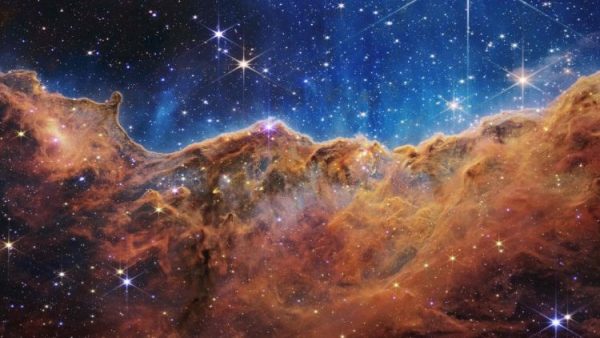Vatican astronomer: Webb telescope images ‘beyond a dream’
 The Director of the Vatican Observatory, Br Guy Consolmagno SJ, describes the new photos from the James Webb telescope as “draw droppingly exciting,” images that offer “a tantalizing glimpse of what we’ll be able to learn about the universe with this telescope in the future.”
The Director of the Vatican Observatory, Br Guy Consolmagno SJ, describes the new photos from the James Webb telescope as “draw droppingly exciting,” images that offer “a tantalizing glimpse of what we’ll be able to learn about the universe with this telescope in the future.”
This week NASA unveiled stunning images from the James Webb Space Telescope, saying the most powerful observatory ever launched to space exceeds expectations.
The telescope was built to look farther than ever before, and with greater clarity to the dawn of the universe.
The $9 billion infrared observatory was launched on Dec. 25, 2021 after nearly two decades in the making.
It reached its destination in solar orbit nearly 1 million miles from Earth a month later.
The first image revealed was a "deep field" photo of a distant galaxy cluster, SMACS 0723, showing the most detailed glimpse of the early universe recorded to date.
The new images have been hailed by astronomers, including Br Guy Consolmagno SJ, Director of the Vatican Observatory, who spoke with excitement about the photos, which he said, offer “a tantalizing glimpse of what we’ll be able to learn about the universe with this telescope in the future.”
The Jesuit Brother, an expert in the particular field of planetary astronomy, explained, “we are able to see things that we could never see before because the Webb is designed to look at wavelengths that don’t penetrate the Earth’s atmosphere.” He also said the Webb’s large mirror allows us to see detail that we were previously unable to see.
Food for the spirit
Commenting that these images “are a necessary food for the human spirit,” Br Consolmagno elaborated by recalling his decision, 40 years ago, to join the US Peace Corps, saying to himself, “why am I doing astronomy when there are so many people starving in the world.” He soon found that people in rural Africa, where he was based at the time, were fascinated by the sky, and wanted to know what the rest of the world was finding out. As human beings, “we all have this curiosity about who we are, how we fit into this universe, what’s out there, what’s beautiful… it’s what makes us human,” he said.
The science behind this telescope, noted the Vatican Observatory director, “is our attempt to use our God-given intelligence to understand the logic of the universe. The universe wouldn’t work if it weren’t logical. But as these images show, the universe is not only logical, it is also beautiful. This is God’s creation being revealed to us, and in it we can see both His astonishing power and his love of beauty.”
New generations
He also said that the astronomers involved with the telescope have been given the gift “of being born in the right place at the right time, where they could take advantage of that God given talent… not everybody has that opportunity.”
One of the programmes run at the Vatican Observatory, situated at Castelgandolfo in the Roman Hills, is a biennial Summer School which gives young scientists from around the world an opportunity to learn with the world’s leading experts in astronomy.
Asked what the Webb telescope, and its images mean for new generations of astronomers, Br Consolmagno said it “opens up a whole new window into the origins of the universe and the nature of the atmosphere around other planets, and what it means to be on our planet, and this is something that is being opened up to anyone who is young.”
“I thought it would have been impossible. I wouldn’t have even dreamt that we’d have known about planets around other stars, much less that we could actually measure their atmosphere.”
Future possibilities
Discussing what more we can expect from the Webb, the Jesuit Brother explained that this telescope “is looking both through space and time so that we can see planets around other stars and measure what’s in their atmospheres; we can see stars being formed in distant parts of our own galaxy, and we can see how the galaxies themselves have changed and evolved and grown since they were first made in the Big Bang thirteen plus light billion years ago, at a distance of thirteen billion light years from us.”
Colleagues and friends
Br Consolmagno said there was also a personal reason why he is delighted with this success. “Astronomy is a small field, we astronomers all tend to know one another. Many of the scientists who built the instruments and planned the observations are personal friends of mine.” He also pointed out that two of the instruments on the web telescope were designed at the University of Arizona, which is where the Vatican Observatory has its telescope.
Beyond a dream
Over the decades, the director has witnessed may key events in the field of space exploration, but asked if he ever thought he would be seeing powerful images such as these, he answered, "absolutely not.”
“I thought it would have been impossible. I wouldn’t have even dreamt that we’d have known about planets around other stars, much less that we could actually measure their atmosphere. This is beyond a dream; this is just draw droppingly exciting for me. I’m turning 70 this year; I only regret that I won’t be around for another 50 years to see what comes up by then.”
Lydia O’Kane
Source: vaticannews.va

